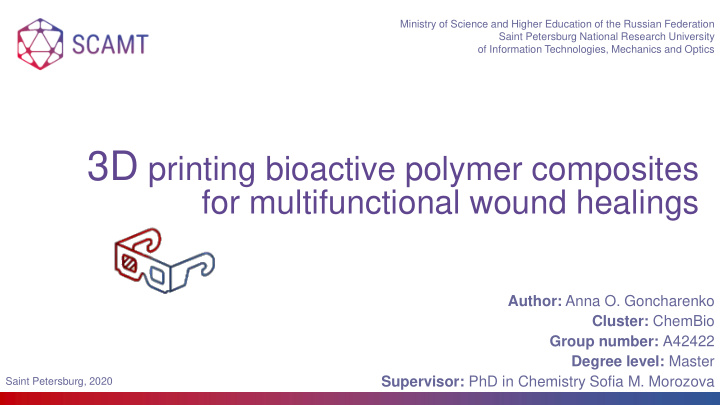



Ministry of Science and Higher Education of the Russian Federation Saint Petersburg National Research University of Information Technologies, Mechanics and Optics 3D printing bioactive polymer composites for multifunctional wound healings Author: Anna O. Goncharenko Cluster: ChemBio Group number: A42422 Degree level: Master Supervisor: PhD in Chemistry Sofia M. Morozova Saint Petersburg, 2020
General issues Why accelerate wound healing? ➢ The healing process consumes the body's internal resources. ➢ During this period, infection of a skin area devoid of natural protection is possible. ➢ The less time we have a wound, the less discomfort. What the solution? An integral part of medical and pharmaceutical wound care is the dressing as a protective barrier. This study aims to 3D print multifunctional hydrogel wound dressings with programmable passive release of antimicrobial and healing agents like growth factor. 2
Research goal and tasks The research goal is a fundamental biological task - to study the effect of bFGF gradient distribution on wound healing. Global research tasks: 1) Chemical / engineering unit: • create a basis for the patch itself - a chitosan framework. Modification of the composition, rheology. • distribute and fix aluminum in the frame. • gradient distribution bFGF (possibly a linear distribution or by the principal targets - a series of gradients) 2) Biological unit: • in vitro experiments: cytological studies (epithelium cell line (B16 - melanoma) - and fibroblasts). • in vivo experiments : a third degree burn model is created on rats. Study of the effect of uniform and gradient FGF presence on the rate of wound healing. 3
Brief description of the essence of the study The resulting hydrogel must not only be suitable for printing, but also have sufficient strength for further use as a base for a patch, which indicates the need to fix the substance by chemical or physical methods. Chitosan with Schematics of the fabrication of 3D printed wound dressings metacrylate groups Alumina Gradient bFGF Aluminum boehmite, evenly distributed in the framework matrix of the hydrogel, will help to restore damaged tissues. The gradient location of the fibroblast growth factor will promote cell proliferation not on the periphery of the wound, followed by pushing back to the center, but moving forward to the A Mixing of CNCs and Chit-MA and biologically active ingredients center, i.e. accelerated. ( ● ) methacrylate groups, ( ⨁ ) positive charge and ( ⊖ ) negative charge. B Formation of shear thinning hydrogel. C Extrusion of the hydrogel (ink) using different printheads to fabricate 4
Results of the work done Chemical reaction equation for the synthesis of modified chitosan (Chit-M) (1) Photo initiator + 1-Hydroxycyclohexyl phenyl ketone At the moment, the process of synthesis (different conditions) and dialysis (2) Crosslinker (different buffers) of modified chitosan (Chit-M) has been optimized. N-N'-Methylenebis (acrylamide) Difficulties arising during the interaction of CNC and Chit-M (inhomogeneous solution) were solved by selecting the ratio of the components, as well as changing the base of the hydrogel (abandoning the CNC, adding PEG, increasing the viscosity of Chit-M) and various consolidation options (UV crosslinking by adding photo initiator (1) and crosslinker (2) or fixation with (3) glutaraldehyde glutaraldehyde(3)). 5
Results of the work done Infill density % In parallel with the optimization, a print test is carried out. Determination of the required pattern parameters and print settings for our hydrogel. 30 25 20 15 The PEG-printed patterns with varying infill densities. The example of printing with chitosan. 6
Results of the work done Rheology optimization is still ongoing, as the ink does not yet keep the given pattern constantly. Various consequences of fixing with glutaraldehyde (complete drying on top, (it is impossible to remove the pattern from the glass), below the lower concentration of glutaraldehyde followed by washing in water, short time). 7
Conclusion The development stages ❖ The modifying the rheological parameters of ink and optimizing printing parameters [modifying pressure, printing speed, table temperature due to composition (modified and unmodified chitosan, potential presence of impurities, PEG, PVA, PolyDADMAC)], as well as printing and fixation them (curing with UV crosslinking or glutaraldehyde). ❖ After obtaining the required matrix, the task will be to introduce a uniform distribution of alumina as a healing agent. ❖ And only then a uniform and gradient spreading of the growth factor. ❖ After the end of the chemical engineering part, the work goes to the biological unit. 8
THANK YOU FOR YOUR ATTENTION
Recommend
More recommend